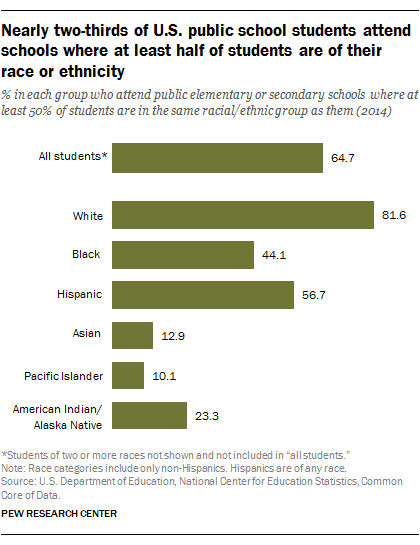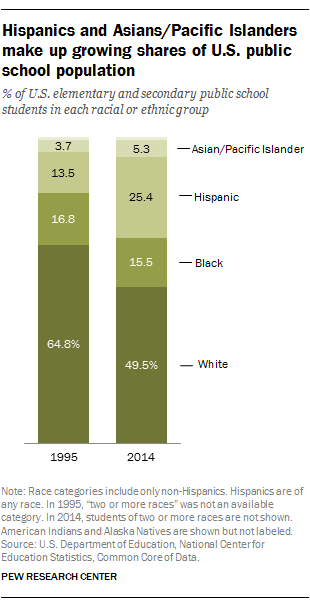
Meanwhile, whites, who continue to make up by far the largest share of the U.S. public school population, tend to go to schools where half or more of students are white.
In 2014, the most recent year for which data are available, 44.1% of black public elementary and secondary school students attended schools where at least half of their peers were also black. Among Hispanics, 56.7% went to schools where at least half of students were also Hispanic.
Since 1995, black public-school students have become somewhat less isolated from students of other racial or ethnic backgrounds, while Hispanics have become more isolated. In 1995, 51.4% of blacks were attending schools where at least half of students were black. Meanwhile, 52.6% of Hispanics were going to schools where half or more students were Hispanic.
These long-term shifts in enrollment are partly the result of the changing racial and ethnic composition of the United States – and, as a result, of its public schools.
The share of Hispanics enrolled in public schools has almost doubled since 1995, when they made up 13.5% of all students. As the share of students who are Hispanic has grown, the share who are black has decreased slightly.

In 2014, about eight-in-ten whites (81.6%) attended schools where at least half of students were also white, a decrease from 90.5% in 1995.
The share of white public-school students attending schools where the vast majority of students are white has also shrunk over the past 20 years. In 1995, nearly half (48.6%) of white public-school students attended schools where at least 90% of students were also white. In 2014, this was the case for just 21.9% of white students. The share of blacks attending schools where at least 90% of students are black has also decreased, from 22.1% in 1995 to 15.4% in 2014. But the share of Hispanics attending schools where at least 90% of students are Hispanic has grown slightly since 1995, from 15.4% to 16.9%.
Asians, who have also driven part of the growth in America's classrooms and in the country overall in recent years, are less likely than whites, blacks and Hispanics to attend schools where at least half of students are their own race or ethnicity. In 2014, just 12.9% of Asians attended schools where this was the case, which is likely due to their relatively small share of the overall public-school population. American Indians, Alaska Natives and Pacific Islanders – who make up even smaller shares of the public student population – were also much less likely than those in other racial or ethnic groups to attend schools where at least half of students are of the same race or ethnicity.
Source: Published originally on pewresearch.org, Many minority students go to schools where at least half of their peers are their race or ethnicity, by Abigail Geiger, October 25th , 2017.